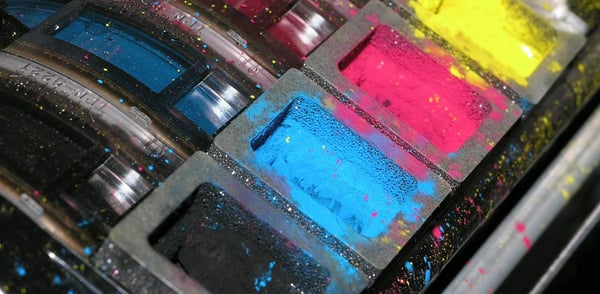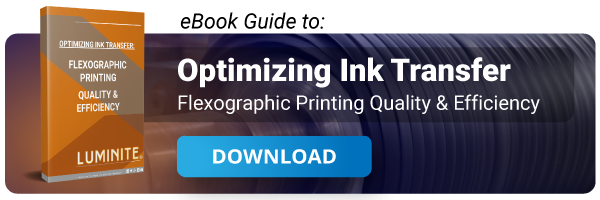Share this
Better Flexo Ink Bonding Begins With The Right Ink Choice
by Luminite on Jul 2, 2018 1:12:23 PM

Flexographic printing works effectively on varied materials like paper, plastic, metallic film, and cellophane to produce a quality job; and presses can be run cost-effectively at extremely high speeds for long runs and large orders.
A great looking design can be ruined if the ink does not adhere properly, causing delays and cost overruns.
The trick is to know how each decision impacts the final outcome. Here are some tips and tricks to help you achieve better ink bonding during the flexographic printing process.
Use The Right Ink For Better Flexo Ink Bonding
Flexographic printing can use a wide range of inks, but the different types will adhere differently to the substrate:
Water-Based Inks
Because these inks generally have the highest surface tension and they work great for printing on corrugated packaging and other absorbent substrates. With the proper surface treatments, they also work well on film.
Solvent-Based Inks
Composed mainly of alcohol, acetate, and pigment, solvent-based inks have a lower surface tension and quicker drying time than water-based. They are usually used for printing flexible packaging or industrial films.
Curable Inks
These inks are composed of monomers, prepolymers, photo initiators, and pigments that dry and adhere only when exposed to an ultraviolet light or electron beam. They have a higher viscosity and are appropriate for the outer wraps of food packaging.
Additionally, they provide excellent resistance to chemical and physical degradation without additional protective varnish and are commonly used for label printing.
Oil-Based Inks
These can be composed of hydrocarbons and pigments, but some of the solvents can be very harsh. These inks are used most often for printing publications and medical charts/ graphs.
Best Practices for Flexographic Ink BondingIn theory, any ink in the right formulation could work on nearly any substrate, but some combinations just work better than others. Other considerations to keep in mind include:
Surface Tension
Since inks naturally want to flow to the higher dyne level, the ink should be at a lower dyne level, the printing surface should be at a higher level, and the substrate should be at the highest dyne level. This allows more ink to transfer and bond to the substrate.
We have a complete guide to measuring surface tension here!
Substrate Absorbency
If the substrate is absorbent, both water-based and solvent-based inks dry satisfactorily. If the substrate is non-absorbent, then it becomes harder to ensure that the ink dries properly. Make sure that your non-absorbent film is treated higher than your inks.
Additionally, working with solvent-based inks and curable inks may also help with absorbency issues.
- For solvent-based inks since they dry by evaporation, a treatment method that increases surface tension is best for optimizing adhesion.
- For water-based inks, the substrate surface should be about 10 dynes/cm higher than the surface energy of the ink so that the ink resin and binder can adhere effectively.
- Curable inks generally have a high surface tension, which means the surface energy must also be quite high.
Best Materials for Flexographic Image Carriers
The final piece of the better ink bonding puzzle is the material of the flexographic image carrier itself. The choice of elastomer sleeves, cylinders, and plates versus photopolymer sleeves, cylinders, and plates affects how well the selected ink is transferred onto the specific substrate.
If you’re looking to optimize your ink bonding, talk to a printing expert about your options. Luminite has 30+ materials to choose from, and one of our experienced printing technicians can walk you through the best options for your ink bonding.
Editor's Note: This article was originally published on July 2, 2018 and was updated on July 29, 2019 to reflect updated information and additional resources.
Share this
- Flexographic Printing (81)
- Image Carrier (28)
- Elastomer sleeves (27)
- Ink Transfer (25)
- Quality (22)
- Flexo sleeve (20)
- News (18)
- printing defects (18)
- flexo printing defects (17)
- sustainability (13)
- Flexo Troubleshooting (12)
- Ink (12)
- Digital Printing (10)
- Flexo 101 (10)
- Flexo Inks, (9)
- Anilox (7)
- Blister Packaging (7)
- Cost (6)
- print misregistration (6)
- regulations (6)
- Corrugated Printing (4)
- pinholing (4)
- "Tradeshow (3)
- Digital Flexo (3)
- Gravure Printing (3)
- Insider (3)
- Load-N-Lok (3)
- Wide Web (3)
- direct laser engraving (3)
- flexo-equipment-accessories (3)
- gear marks (3)
- halo (3)
- testing (3)
- Narrow Web (2)
- bridging (2)
- feathering (2)
- filling in (2)
- mottled image (2)
- pressure (2)
- Labelexpo (1)
- dirty prints (1)
- doughnuts (1)
- embossing (1)
- kiss impression (1)
- October 2023 (2)
- September 2023 (1)
- August 2023 (1)
- July 2023 (3)
- June 2023 (1)
- May 2023 (5)
- April 2023 (1)
- March 2023 (2)
- February 2023 (1)
- January 2023 (3)
- December 2022 (1)
- October 2022 (3)
- September 2022 (2)
- August 2022 (2)
- July 2022 (3)
- May 2022 (1)
- April 2022 (4)
- March 2022 (2)
- February 2022 (5)
- January 2022 (7)
- December 2021 (1)
- November 2021 (3)
- October 2021 (2)
- September 2021 (1)
- August 2021 (1)
- July 2021 (3)
- June 2021 (1)
- May 2021 (4)
- April 2021 (4)
- March 2021 (4)
- February 2021 (2)
- December 2020 (1)
- November 2020 (1)
- October 2020 (2)
- September 2020 (1)
- August 2020 (3)
- July 2020 (2)
- June 2020 (3)
- May 2020 (1)
- April 2020 (1)
- November 2019 (3)
- October 2019 (1)
- August 2019 (1)
- July 2019 (1)
- April 2019 (1)
- March 2019 (1)
- January 2019 (1)
- October 2018 (2)
- August 2018 (1)
- July 2018 (1)
- June 2018 (1)
- February 2018 (2)
- October 2017 (1)
- September 2017 (2)
- January 2016 (1)
- February 2015 (1)
- January 2015 (1)
- December 2014 (2)
- September 2014 (1)
- February 2014 (1)
- January 2014 (1)
- December 2013 (3)
- October 2013 (1)
- September 2013 (1)
- June 2013 (1)
- January 2013 (1)


Comments (4)